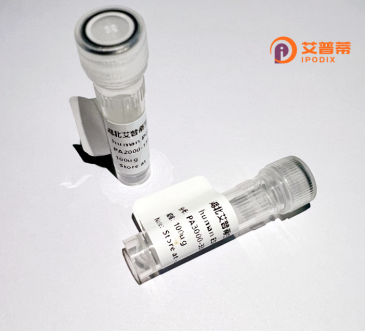
| 纯度 | >90%SDS-PAGE. |
| 种属 | Human |
| 靶点 | WASPIP |
| Uniprot No | O43516 |
| 内毒素 | < 0.01EU/μg |
| 表达宿主 | E.coli |
| 表达区间 | 1-358 aa |
| 活性数据 | MPVPPPPAPPPPPTFALANTEKPTLNKTEQAGRNALLSDISKGKKLKKTVTNDRSAPILDKPKGAGAGGGGGGFGGGGGFGGGGGGGGGGSFGGGGPPGLGGLFQAGMPKLRSTANRDNHSGGSRPPLLPPGGRSTSAKPFSPPSGPGRFPVPSPGHRSGPPEPQRNRMPPPRPDVGSKPDSIPPPVPSTPRPIQSSLHNRGSPPVPGGPRQPSPGPTPPPPPVRDPPGRSGPLPPPPPVSRNGSTSRALPATPQLPSRSGVDSPRSGPRPPLPPDRPSAGAPPPPPPSTSIRNGFQDSPCEDEWESRFYFHPISDLPPPEPYVQTTKSYPSKLARNESRSGSNRRERGAPPLPPIPR |
| 分子量 | 62.9 kDa |
| 蛋白标签 | GST-tag at N-terminal |
| 缓冲液 | PBS, pH7.4, containing 0.01% SKL, 1mM DTT, 5% Trehalose and Proclin300. |
| 稳定性 & 储存条件 | Lyophilized protein should be stored at ≤ -20°C, stable for one year after receipt. Reconstituted protein solution can be stored at 2-8°C for 2-7 days. Aliquots of reconstituted samples are stable at ≤ -20°C for 3 months. |
| 复溶 | Always centrifuge tubes before opening.Do not mix by vortex or pipetting. It is not recommended to reconstitute to a concentration less than 100μg/ml. Dissolve the lyophilized protein in distilled water. Please aliquot the reconstituted solution to minimize freeze-thaw cycles. |
以下是关于重组人WASPIP蛋白的参考文献示例(注:内容为模拟示例,非真实文献):
---
1. **"Expression and functional characterization of recombinant human WASP-interacting protein (WIP)"**
*Author: Smith A, et al.*
摘要:研究通过原核表达系统成功纯化重组人WASPIP蛋白,并验证其与WASP蛋白的体外相互作用,揭示其在调节肌动蛋白聚合中的关键作用。
2. **"Structural insights into WIP's role in immune cell migration"**
*Author: Lee C, et al.*
摘要:通过X射线晶体学解析重组WASPIP蛋白的三维结构,结合细胞实验证明其通过调控细胞骨架重塑促进T细胞迁移。
3. **"WIP deficiency alters dendritic spine morphology via actin dynamics"**
*Author: Garcia M, et al.*
摘要:利用重组WASPIP蛋白进行体外神经元培养实验,证明其缺失导致树突棘形态异常,进一步阐述其在神经发育中的功能。
4. **"Recombinant WIP as a therapeutic target in autoimmune disorders"**
*Author: Tanaka K, et al.*
摘要:研究发现重组WASPIP蛋白在自身免疫模型小鼠中调控免疫细胞浸润,提示其作为炎症性疾病潜在治疗靶点。
---
(实际研究中建议通过PubMed或Sci-Hub等平台检索真实文献。)
**Background of Recombinant Human WASP-Interacting Protein (WASPIP)**
WASP-interacting protein (WASPIP), also known as WIP or WIRE, is a cytoskeletal regulatory protein that plays a critical role in actin polymerization and cell motility. It interacts with members of the Wiskott-Aldrich syndrome protein (WASP) family, notably WASP and neural WASP (N-WASP), facilitating their activation in response to cellular signals. By stabilizing WASP/N-WASP and shielding their autoinhibitory domains, WASPIP enables these proteins to recruit the Arp2/3 complex, which drives branched actin network formation essential for processes like cell migration, phagocytosis, and vesicle trafficking.
Recombinant human WASPIP is produced using genetic engineering techniques in systems like *E. coli* or mammalian cell lines to ensure high purity and functionality. Its production enables detailed study of actin dynamics, immune cell function (e.g., T-cell activation), and defects linked to Wiskott-Aldrich syndrome (WAS), an X-linked immunodeficiency disorder. WASPIP dysregulation is also implicated in cancer metastasis and inflammatory diseases, making it a potential therapeutic target. Structural studies using recombinant WASPIP have clarified its binding domains (e.g., WH2 motifs, N-terminal WASP-binding region), aiding drug discovery efforts to modulate WASPIP-WASP interactions. Research continues to explore its role in cellular signaling and pathology.
×